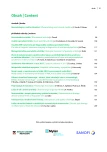Treat to target in gouty arthritis
Authors:
Karel Pavelka
Authors‘ workplace:
Revmatologický ústav, Praha
Published in:
Vnitř Lék 2018; 64(2): 185-190
Category:
Reviews
Overview
Gout is a crystal-induced, metabolically determined inflammatory rheumatic disease with increasing prevalence. In clinical practice, gout causes frequent diagnostic as well as therapeutic problems. The golden diagnostic standard is crystalographic analysis and evidence of monosodium urate crystals in the polarization microscope; if this is not available, the diagnosis can be established through a combination of clinical, laboratory and imaging techniques. The acute gouty attack must be treated by quick administration of anti-inflammatory medicines, with available alternatives being nonsteroidal antirheumatic drugs (NSA), colchicine and glucocorticoids. When the attack subsides, hypouricemic therapy is initiated which should combine the regimen and diet measures and pharmacological treatment. Recommendations for the treatment of gout were published by the EULAR and the Czech Society for Rheumatology. Recently a new strategy appeared known as Treat to target – T2T. This principle has been successfully used in the treatment of rheumatiod arthritis and spondyloarthritis. The publication is structured as four overarching principles and nine Recommendations. The recommendations emphasize long-term maintenance of serum levels of uric acid below 360 μmol/l as the basic gout-related target in all patients, and below 300 μmol/l for patients with tophies. It is recommended to administer prophylactic small doses of colchicine for at least 3–6 months on the commencement of hypouricemic therapy. The Recommendations further emphasize the need for regular monitoring of comorbidities and the kidney function. A separate recommendation is concerned with necessary education of patients and their motivation toward compliance with regimen measures and increased physical activity.
Key words:
colchicine – gouty arthritis – treat to target principle
Sources
1. Richette P, Bardin T. Gout. Lancet 2010; 375(9711): 318–328. Dostupné z DOI: <http://dx.doi.org/10.1016/S0140–6736(09)60883–7>.
2. Kostalova E, Pavelka K, Vlaskova H et al. Hyperuricemia and gout due to deficiency of hypoxanthine-guanine phosphoribosyltransferase in female carriers: New insight to differential diagnosis. Clin Chim Acta 2015; 440 : 214–217. Dostupné z DOI: <http://dx.doi.org/10.1016/j.cca.2014.11.026>.
3. Kuo CF, Grainge MJ, Mallen C et al. Comorbidities in patients with gout prior to and following diagnosis: case – control study. Ann Rheum Dis 2016; 75(1): 210–217. Dostupné z DOI: <http://dx.doi.org/10.1136/annrheumdis-2014–206410>.
4. Shields GE, Beard SM. A systematic review of the economic and humanistic burden of gout. Pharmacoeconomics 2015; 33(10): 1029–1047. Dostupné z DOI: <http://dx.doi.org/10.1007/s40273–015–0288–5>.
5. Khanna PP, Fitzgerald J. Evolution of management of gout: a comparison of recent guidelines. Curr Opin Rheumatol 2015; 27(2): 139–146. Dostupné z DOI: <http://doi.10.1097/BOR.0000000000000154>.
6. Pavelka K. Doporučení České revmatologické společnosti pro léčbu dnavé artritidy. Čes Revmatol 2012; 20(2): 82–92.
7. Terkeltaub RA, Furst DE, Bennet K et al. High versus low dosing of oral colchicine for early acute gout flare: Twenty-four-hour outcome of the first multicenter, randomized, double-blind, placebo-controlled, parallel-group, dose-comparison colchicine study. Arthritis Rheum 2010; 62(4): 1060–1068. Dostupné z DOI: <http://dx.doi.org/10.1002/art.27327>.
8. Schlesinger N, Alten RE, Bardin T et al. Canakinumab for acute gouty arthritis in patients with limited treatment options: results from two randomised, multicentre, active controlled, double blind trials and their initial extensions. Ann Rheum Dis 2012; 71(11): 1839–1848. Dostupné z DOI: <http://dx.doi.org/10.1136/annrheumdis-2011–200908>.
9. Becker MA, Schumacher HR, Wortman RL et al. Effects of febuxostat versus allopurinol and placebo reducing serum urate in subjects with hyperuricemia and gout: a 298, phase III. Randomised trial. Arthritis Care Res 2008; 59(11): 1540–1548. Dostupné z DOI: <http://dx.doi.org/10.1002/art.24209>.
10. Smolen J, Aletaha D, Bijlsma JW et al. Treating rheumatoid arthritis to target: recommendations of an international task force. Ann Rheum Dis 2010; 69(4): 631–637. Dostupné z DOI: <http://dx.doi.org/10.1136/ard.2009.123919>. Erratum in Ann Rheum Dis 2011; 70(7): 1349. [van der Heijde D]. Ann Rheum Dis. 2011; 70(8): 1519.
11. Coates LC, Moverly AR, McParland L et al. Effect of tight control of inflammation in early psoriatic arthritis (TICOPA): a UK multicentre, open label, randomised controlled trial. Lancet 2015; 386(10012): 2489–2498. Dostupné z DOI: <http://dx.doi.org/10.1016/S0140–6736(15)00347–5>.
12. Kiltz U, Smolen J, Bardin T et al. Treat to target (T2T) recommendations for gout. Ann Rheum Dis 2017; 76(4): 632–638. Dostupné z DOI: <http://dx.doi.org/10.1136/annrheumdis-2016–209467>.
13. Perez Ruiz F, Calabozo M, Pijoan JI et al. Effect of urate lowering therapy on the velocity of size reduction of tophi in chronic gout. Arthritis Rheum 2002; 47(4): 356–360. Dostupné z DOI: <http://dx.doi.org/10.1002/art.10511>.
14. Peters MJ, Symmons DP, McCarey D et al. EULAR evidence-based recommendations for cardiovascular risk management in patients with rheumatoid arthritis and other forms of inflammatory arthritis. Ann Rheum Dis 2010; 69(2): 325–331. Dostupné z DOI: <http://dx.doi.org/10.1136/ard.2009.113696>.
Labels
Diabetology Endocrinology Internal medicineArticle was published in
Internal Medicine

2018 Issue 2
Most read in this issue
- Axial spondyloarthritis
- The role of magnetic resonance imaging in diagnostics of axial spondyloarthritis
- Idiopathic inflammatory myopathies
- Diffuse alveolar hemorrhage – acute, life-threatening situation in rheumatology
